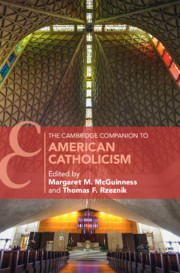Book contents
- The Cambridge Companion to American Catholicism
- Cambridge Companions to Religion
- The Cambridge Companion to American Catholicism
- Copyright page
- Contents
- Contributors
- Introduction
- Part I Historical Overview
- Part II Catholic Life and Culture
- 4 Catholic Worship
- 5 Catholic Intellectual Life
- 6 Catholic Education
- 7 Social Welfare and Social Reform
- 8 Women Religious
- 9 Catholics and Politics
- 10 Arts and Culture
- 11 Anti-Catholicism in the United States
- 12 Gender and Sexuality
- 13 American Catholics in a Global Context
- Part III The Many Faces of Catholicism
- Part IV Conclusion
- Index
- Series page
- References
6 - Catholic Education
from Part II - Catholic Life and Culture
Published online by Cambridge University Press: 27 May 2021
- The Cambridge Companion to American Catholicism
- Cambridge Companions to Religion
- The Cambridge Companion to American Catholicism
- Copyright page
- Contents
- Contributors
- Introduction
- Part I Historical Overview
- Part II Catholic Life and Culture
- 4 Catholic Worship
- 5 Catholic Intellectual Life
- 6 Catholic Education
- 7 Social Welfare and Social Reform
- 8 Women Religious
- 9 Catholics and Politics
- 10 Arts and Culture
- 11 Anti-Catholicism in the United States
- 12 Gender and Sexuality
- 13 American Catholics in a Global Context
- Part III The Many Faces of Catholicism
- Part IV Conclusion
- Index
- Series page
- References
Summary
The growth and development of Catholic schools in the United States represented an ambitious, ideologically motivated, and faith-based effort on the part of both church leaders and the Catholic faithful to educate youth and young adults and provide an alternative to public schools, which were considered hostile to the tenets of Catholicism. The opening of the Ursuline Academy in New Orleans in 1727 laid a foundation for the most extensive privately funded system of schools in history. The Catholic school system – both parish schools and private institutions founded by religious orders – grew at a slow rate in the early years of the republic, but quickly accelerated with the arrival of Catholic immigrants at the midpoint of the nineteenth century, primarily from Ireland and Germany. This growth continued unabated until the mid-1960s, when the baby boom generation fueled demands for seats in classrooms across the nation. In 1965, the apex of Catholic school enrollments, 4.5 million children attended parish elementary schools. Over the years, the Catholic Church built an incredible network of educational institutions in every corner of the nation.
- Type
- Chapter
- Information
- The Cambridge Companion to American Catholicism , pp. 105 - 122Publisher: Cambridge University PressPrint publication year: 2021

